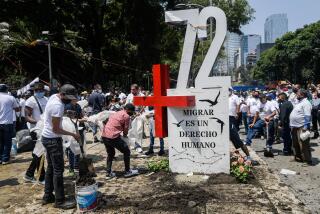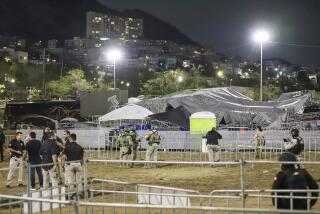Death toll from Mexico’s earthquake climbs to 230 as frantic search continues for survivors

Mexico’s seismological agency said the epicenter was east of the capital in the state of Puebla. (Sept. 20, 2017)
- Share via
Reporting from MEXICO CITY — Firefighters, soldiers and volunteers, at times working with bare hands and donated flashlights, searched massive piles of rubble for any signs of life Wednesday after a violent earthquake that toppled buildings across central Mexico.
There were moments of relief when still-breathing, dust-covered survivors were pulled from the wreckage and transported to hospitals. But many others were found dead.
Tuesday’s magnitude 7.1 earthquake, the second to strike Mexico in as many weeks, killed at least 230 people in the capital and across five states. Officials said the toll was likely to rise.
Some of the most heart-wrenching scenes played out at a three-story school building that pancaked into a pile of concrete rubble on the south side of Mexico City. Rescue workers extracted at least 25 bodies from the ruins, all but four of them children.
Five people were killed at the Mexico City campus of the Monterrey Institute of Technology and Higher Education, the school said in a statement. Scores more died in collapsed apartment buildings and office towers.
The quake hit on the anniversary of a 1985 temblor that killed thousands and devastated large parts of Mexico City. The epicenter was in the state of Puebla, about 80 miles southeast of the capital.
President Enrique Peña Nieto toured some of the worst-hit parts of the city and also visited the state of Morelos. He declared three days of national mourning to honor the victims, telling their relatives and loved ones, “Mexico shares your pain.”
With glass and debris strewn across the capital and power still out in places, many residents would need help in the coming days, he said in a video address to the nation late Tuesday. But the first priority would be to rescue those still trapped under the rubble and provide medical care to the injured.
“As Mexicans, we have experienced difficult times because of earthquakes in the past, and we have learned to respond with dedication and a spirit of solidarity,” he said.
President Trump called his Mexican counterpart Wednesday to extend his condolences for the lives lost and damage caused by the quake, according to a statement from the White House. Trump also offered assistance, including search-and-rescue teams, which were being deployed to Mexico, the statement said.
The president was criticized by opponents for not immediately expressing sympathy for Mexico after another deadly earthquake struck off the country’s southern coast on Sept. 7 and a hurricane made landfall two days later. At the time, Trump blamed poor cellphone reception in the mountains of Mexico for the delay in reaching Peña Nieto.
“God bless the people of Mexico City,” Trump tweeted Tuesday. “We are with you and will be there for you.”
Federal authorities in Mexico struggled to confirm the number of dead and injured amid the chaos of a rescue operation spread across hundreds of miles, revising their figures several times Wednesday.
As of Wednesday evening, the death toll stood at 230, according to a tweet from Luis Felipe Puente, Mexico’s national coordinator for civil protection. They included 100 people killed in the autonomous district of Mexico City, 69 in Morelos, 43 in the state of Puebla and 13 in Mexico state. There were four deaths in Guerrero state and one in Oaxaca state.
At least 800 people were injured in Mexico City. Signs of the quake were all over the city Wednesday: broken glass under a business awning; swept-up piles of brick, concrete and steel rebar; caution tape blocking structurally unsound doorways.
School was canceled for the day and many businesses were closed, alleviating the city’s usual heavy traffic.
Hordes of people gathered at the sites of dozens of collapsed buildings. They came from all walks of life, bringing water, food and safety supplies. They asked how they might help. There were so many of them that sometimes they had to be turned away.
Outside a damaged apartment building in the neighborhood of Lindavista, north of the city center, dozens of volunteers formed a human chain, passing jugs of water, rope, hard hats and shovels. Police officers kept order, blowing whistles as they directed Red Cross and other emergency crews.
Aides at the scene said the bottom three floors of the six-story building had caved in, trapping people inside.
“Medico!” someone yelled from beyond an orange barrier set up to keep the public at bay. Two women in white doctor’s coats sprang over the blockade, one of them nearly tripping on her way, and ran toward the wreckage.
As workers shoveled away rubble, word spread that the building was in danger of further collapse. Trucks soon arrived at the barrier with thick wooden posts to reinforce the collapsed third floor, which was held up precariously by the first floor’s pillars.
Across the region, authorities appealed for donations of food and water to sustain rescuers and for flashlights to assist the searches that would go on into the night.
18 hours after the collapse, rescuers still paused every few minutes to listen for survivors.
In the upscale neighborhood of Condesa, in the center of Mexico City, several dozen people pressed against police tape surrounding a collapsed office building, watching in anxious silence as ambulances circled with sirens blaring and firefighters desperately searched the rubble for survivors.
They were the mothers, sisters, cousins, husbands and wives of people trapped inside the wreckage of the multistory building.
In the the seven hours that Concepcion Chavez Lopez had been waiting there, she had seen more than a dozen people pulled alive from the wreckage. None had been her son, Gustavo Banda Chavez, 23, or her brother, Miguel Angel Chavez Lopez, 48, who worked together in an accounting firm on the building’s fourth floor.
Chavez, 51, could barely utter her name when someone asked for it shortly before midnight Tuesday. She and a small group of relatives kept their eyes trained on the scene in front of them: firefighters picking their way across a towering heap of bricks, chunks of concrete and twisted metal, their work illuminated by floodlights.

Hurricane Maria evacuee Josefina Bayes de la Paz at the shelter at Roberto Clemente Coliseum in San Juan, Puerto Rico.
As he stood watching the office building, all Alejandro Santiago hoped for was to hear the name Paulina Gomez.
It would mean that somebody had found his 28-year-old cousin , a human resources administrator who worked on the fourth floor, somewhere beneath the rubble. It would mean that her name could join the list of people who had been rescued, which authorities were writing on a piece of poster board attached to a light post.
But Santiago, also 28, hadn’t heard anything. So he waited, and watched. At one point, police had asked the family members to move farther from the scene. They refused.
“We’re not moving until we find out what happened to them,” he said.
Miguel Angel Pimienta Avalos, 63, arrived outside a collapsed apartment block in Condesa at 10 p.m. Tuesday hoping to find his niece, who lived on the fifth floor of the six-story building.
When the quake hit, he had called every family member to make sure they were safe. She was the only person who didn’t answer.
“When I saw the photos on the Internet, I said, ‘It’s not likely that they’ll get people out,’ ” he said, looking away as he fought back tears. “Hopefully there is a miracle.”
Just across from the apartments, medics had turned a building for representatives from the state of Durango into a makeshift base for family members of the missing. Members of 13 families had signed in throughout the night. None of their loved ones had been found by morning, and most had left by daybreak.
Ten hours after he arrived, Avalos was the only one left, volunteering to pass the time, and praying to God.
Nurses set up a sidewalk clinic, while others walked around offering pastries and water. Dozens of people stood watch, their mouths covered with face masks, as volunteers atop a mountain of rubble passed debris down in buckets. Others carted rubble away from the ground in wheelbarrows.
One rescue worker brought a yellow Labrador retriever to the top of the pile to sniff out bodies. Suddenly, workers dimmed the lights, cut off the generators and called for silence. They listened. A few minutes later, they resumed their work.
By nightfall, the mound had been reduced. It had a slope instead of a peak.Workers pounded at what remained of apartments with sledgehammers and cut through pieces of metal rebar with a torch.
They barely paused to put on plastic ponchos when a storm hit the city around 7:30 p.m., dropping sheets of rain onto the site and making the mountain look soggy.
Dr. Karen Pina Fragoso, who was working at the scene, said a handful of people had survived the collapse. Two walked out on their own Tuesday night, and three or four were rushed to a hospital. She didn’t know how many adults remained missing in the building, but said at least three children were unaccounted for.
Fragoso said medics could still hear the voices of many people trapped in the building at 3 a.m. But as daylight broke, the voices quieted.

Times staff writers Linthicum and Castillo reported from Mexico City and Zavis from Los Angeles. Staff writers Ruben Vives in Los Angeles and Brian Bennett in New York contributed to this report.
ALSO
Airline passengers arriving in California from Mexico City describe feeling quake from the tarmac
Mexico quake hit on the anniversary of a 1985 temblor that killed thousands
UPDATES:
6:40 p.m.: This article was updated with a heavy rain storm hitting Mexico City and rescue efforts continuing into the night.
5 p.m.: This article was updated with the death toll climbing to 230, description of the search efforts and other details.
11:55 a.m.: This article was updated with details of the damage, a declaration of three days of national mourning and President Trump’s call to Mexican Enrique Peña Nieto.
8:00 a.m.: This article was updated with the scene at a collapsed building.
This story was originally published at 7:35 a.m.
More to Read
Sign up for Essential California
The most important California stories and recommendations in your inbox every morning.
You may occasionally receive promotional content from the Los Angeles Times.













